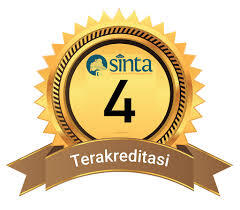Implementasi Model SAMR (Substitution, Augmentation, Modification, Redefinition) di MI Al-Ishlah Glagah Lamongan
 Abstract views: 7109
,
Abstract views: 7109
,
 PDF downloads: 1589
PDF downloads: 1589
Abstract
Educational technology is an applied discipline that develops according to the needs and demands of society. SAMR is a Computer technology-based learning model popularized by Ruben Puentedura. The purpose of this study is to provide an alternative for educators to be able to integrate technology. This research method uses qualitative methods with data collection techniques through interviews, observation, and online documentation. The results of this study found that the SAMR learning model is not new in the world of education in the country. SAMR has similarities with bloom's taxonomic theory, which has a stage that to like a ladder. So this discussion is exciting to be researched and implemented at elementary level students.
Abstrak
Teknologi pendidikan merupakan suatu disiplin ilmu terapan yang berkembang sesuai kebutuhan dan tuntutan masyarakat. SAMR merupakan model pembelajaran berbasis teknologi komputer yang di populerkan oleh Ruben Puentedura. Tujuan penelitian ini adalah untuk memberikan alternative kepada pendidik agar dapat mengintegrasikan tehnologi ke dalam pembelajaran. Metode penelitian ini menggunakan metode kualitatif dengan tehnik pengumpulan data melalui wawancara, observasi dan dokumentasi secara online. Hasil penelitian ini menemukan bahwa model pembelajaran SAMR ini bukanlah hal baru dalam dunia pendidikan di tanah air, SAMR memiliki kesamaan dengan teori taksonomi bloom yang memiliki tahapan yang diibaratkan seperti anak tangga. Sehingga pembahasan ini menarik untuk diteliti dan diimplementasikan pada siswa tingkat dasar.
Downloads
References
Berliner, D. C. “Comment: Educational Research: The Hardest Science of All.” Educational Researcher, 31(8), 18–20., 2002. https://doi.org/10.3102/ 0013189x031008018.
Fitriansyah, Fifit. “PEMANFAATAN MEDIA PEMBELAJARAN (GADGET) UNTUK MEMOTIVASI BELAJAR SISWA SD.” Cakrawala, no. 2 (2016).
Hamilton, Erica R, Joshua M Rosenberg, and Mete Akcaoglu. “The Substitution Augmentation Modification Redefinition (SAMR) Model: A Critical Review and Suggestions for Its Use.” TechTrends 60, no. 5 (2016): 433–41. https://doi.org/10.1007/s11528-016-0091-y.
Hennessey, S., Ruthven, K., & Brindley, S. “Teacher Perspectives on Integrating ICT into Subject Teaching: Commitment, Constraints Caution, and Change.” Journal of Curriculum Studies, 37(2), 2005. https://doi.org/Doi:10.1080/0022027032000276961, 192.
Hussin, Anealka Aziz. “Education 4 . 0 Made Simple : Ideas For Teaching,” no. c (2018): 92–98.
Imam Gunawan, Anggraini Retno palupi. “REVISI TAKSONOMI BLOOM RANAH KOGNITIF: KERANGKA LANDASAN UNTUK PEMBELAJARAN, PENGAJARAN, DAN ASESMEN” 2, no. 1 (2012): 98–117.
Lexy J. Moleong. Metodologi Penelitian Kualitatif, Cet.20. Bandung: Remaja Rosda Karya, 2009.
Namiroh, Siti dkk. “Peran Multimedia Dalam Pembelajaran.” Prosiding Seminar Dan Diskusi Nasional Pendidikan Dasar, 2018, 352–57. https://doi.org/25285564.
Puentedura, Ruben R. “The SAMR Model: Background and Exemplars.” Retrieved June 24 (2012): 2013.
Putrawangsa, Susilahudin, and Uswatun Hasanah. “Integrasi Teknologi Digital Dalam Pembelajaran Di Era Industri 4.0.” Jurnal Tatsqif 16, no. 1 (2018): 42–54. https://doi.org/10.20414/jtq.v16i1.203.
Rusydiyah, Evi Fatimatur. TEKNOLOGI PEMBELAJARAN Implementasi Pembelajaran Era 4.0. Surabaya: UIN Sunan Ampel Press, 2019.
Sugiono. Memahami Penelitian Kualitatif. Bandung: Alphabeta, 2015.
Wibawanto, Hari, Hari Wibawanto, and Universitas Negeri Semarang. “Model Evaluasi Integrasi Tik Dalam Pembelajaran” 4, no. 2006 (2019): 12–21.
https://edtech4beginners.com/2016/12/05/what-is-the-samr-model/ diakses tanggal 1 Maret 2020
https://www/shrockguide.net/samr.html diakses tanggal 1 Maret 2020
https://www.youtube.com/watch?v=SC5ARwUkVQg . diakses tanggal 07 Mei 2020
Copyright (c) 2021 TADRIS: Jurnal Pendidikan Islam

This work is licensed under a Creative Commons Attribution-NonCommercial 4.0 International License.
The journal operates an Open Access policy under a Creative Commons Non-Commercial 4.0 International license. Authors who publish with this journal agree to the following terms:
- Authors retain copyright and grant the journal right of first publication with the work simultaneously licensed under a
 Commons Attribution-NonCommercial 4.0 International License
Commons Attribution-NonCommercial 4.0 International Licensethat allows others to share — copy and redistribute the material in any medium or format, and adapt — remix, transform, and build upon the material.
- Authors are able to enter into separate, additional contractual arrangements for the non-exclusive distribution of the journal's published version of the work (e.g., post it to an institutional repository or publish it in a book), with an acknowledgement of its initial publication in this journal.
- Authors are permitted and encouraged to post their work online (e.g., in institutional repositories or on their website) prior to and during the submission process, as it can lead to productive exchanges, as well as earlier and greater citation of published work (see The Effect of Open Access).














